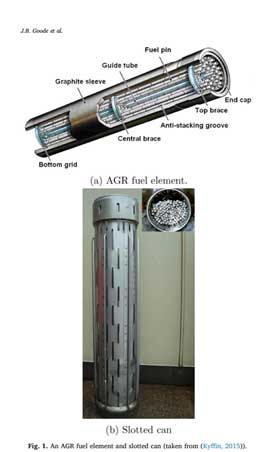Advanced Gas cooled Reactor (AGR) fuels were reprocessed at Sellafield until 2018. The Nuclear Decommissioning Authority’s strategy for the remaining AGR fuel is to consolidate at Sellafield and store in appropriate ponds pending a government decision on whether to declare the fuels as waste for disposal , and dispose of accordingly. In AGR fuel, the uranium dioxide fuel pellets are clad with stainless steel to make fuel pins. A small proportion of this fuel is susceptible to the failure of the stainless-steel cladding due to intergranular stress corrosion cracking. While empirical evidence has shown that this can be prevented by using a corrosion inhibitor, Sellafield wanted to carry out further research to explore the potential contingency option of dry storage for the failed pins. One key area of interest is the efficacy of the drying process, that is determining the mass of water that can be removed by vacuum drying. This extraction is important to prevent water related chemical reactions with the spent fuel pellets occurring within the pin. However, quantifying the extracted water is complex. It is impractical to measure the tiny change in mass of a large pin assembly by weighing it. Conventionally, a humidity measurement could quantify the amount of water vapour in a known amount or volume of background gas. However, the process of continuous extraction, together with vacuum conditions, make this approach unviable as the volume of background gas is unknown. Sellafield approached NPL to provide a new technique to reliably quantify the amount of extracted water from failed spent fuel pins.
.jpg?lang=en-US)
NPL worked with the National Nuclear Laboratory (NNL) to propose a new approach to evaluating the mass of extracted water from the AGR fuel pins. After eliminating various options, NPL identified a novel way of combining electrolytic measurements of water vapour together with mass-flow metering of the extracted gas mixture, in order to measure an integrated mass of extracted water. This involved adapting the use of a commercially available electrolytic hygrometer to operate at a range of sub-atmospheric pressures, and combining with detailed testing at these conditions. NPL used a primary dew point generator to calibrate the humidity instrument in both air and helium.
Secondly, NPL generated a range of water vapour pressures in air at a range of sub-atmospheric pressures to characterise the hygrometer performance under the planned process conditions. These humidity capabilities, using NPL’s versatile multi-gas multi-pressure primary humidity generator, are at the leading edge of humidity testing and calibration.
The work has allowed NPL and NNL to propose a solution to a challenge in drying storage of spent nuclear fuel pins. As it is unable to be stored in standard storage systems, this drying of the AGR fuel, before long-term storage, will underpin the future management of the waste. The devised approach to measuring extracted water provides a new solution to a challenging measurement problem, with the advantage of building on an existing technology.
NPL’s highly specialised humidity facilities enabled the testing of the adapted use of the electrolytic hygrometer. This can be used to determine the quantity of extracted water from, and so facilitate the reliable storage of, spent fuel pins.
Find out more about NPL’s nuclear metrology research
Find out more about NPL’s surface technology research
Find out more about NPL’s temperature & humidity research
Find out more about NPL’s work in with energy & utilities industry
Find out more about NPL’s work within the environment national challenge